The SIRIUS-19 project is a four-month imitation of an expedition to the moon in a ground complex in Moscow

On March 19, 2019, at 14:00 Moscow time, the SIRIUS-19 experiment was launched to simulate the flight of a six-person crew to the Moon, carried out at the Terrestrial Experimental Complex (NEC) of the Institute of Biomedical Problems of the Russian Academy of Sciences (IBMP) in Moscow on Khoroshevsky Highway.
It is planned that during the 120 days of the isolation experiment, the main elements of a real space flight will be simulated: flight of the crew to the moon, followed by a fly-over and search for a landing site, landing of four crew members to perform surface operations, stay in the Moon’s orbit to receive transport ships and remote control lunar rover to prepare the base, the subsequent return to Earth, the implementation of about 80 scientific experiments (psychological and physiological, physiological, with knitted with immunity, metabolism and telemedicine, microbiological and sanitary-hygienic.).
')
Specialists from the Roscosmos state corporation, RSC Energia, and the CPK them take part in the project. Gagarin, Airbus DS (Germany), NASA, KBRwyle (USA) and other aerospace enterprises from more than 10 countries.
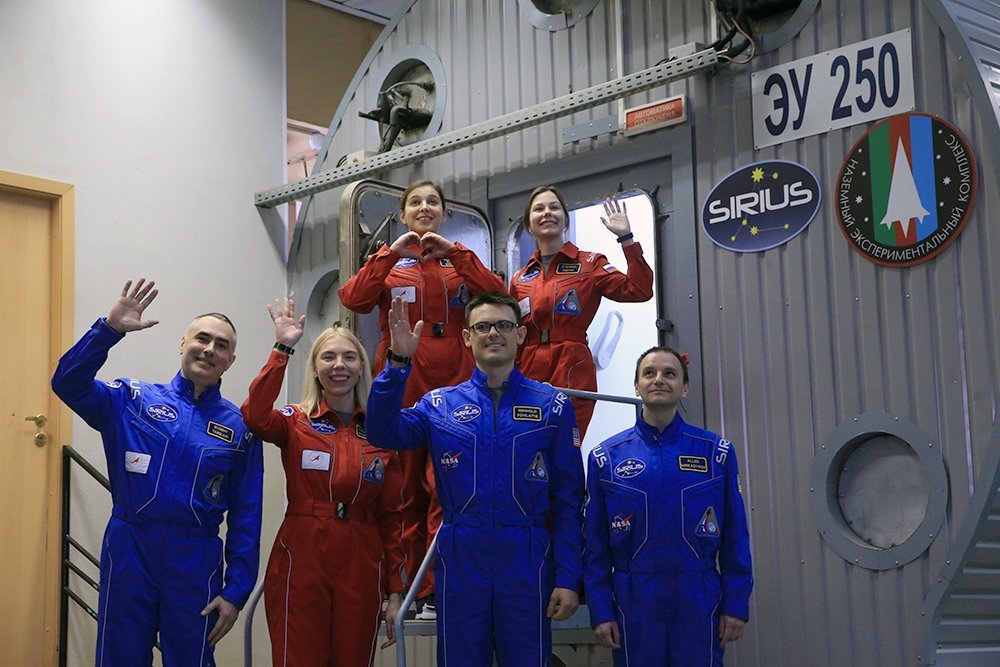
The main mixed international crew of the experiment includes:
- pilot-cosmonaut, test-commander Yevgeny Igorevich Tarelkin (Russia);
- test researcher Anastasia Stepanova (Russia);
- Test-flight engineer Darya Zhidova (Russia);
- test doctor Stefania Fedyai (Russia);
- Reinhold Povilaitis test tester (Reinhold Povilaitis, USA);
- test researcher Allen Mirkadyrov (Allen Mirkadyrov, USA).

The backup crew of the experiment includes:
- Polina Kuznetsova (Russia);
- Daniel Dubar (Belarus).
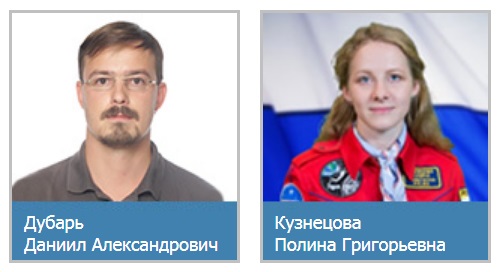
Before the start of the experiment, all participants underwent special background studies and training sessions.
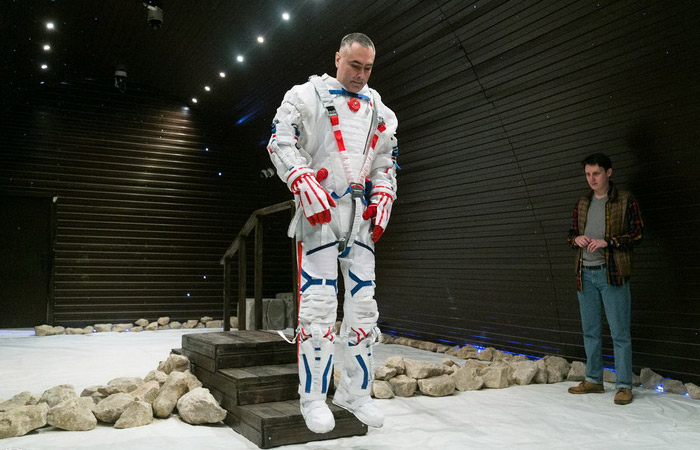
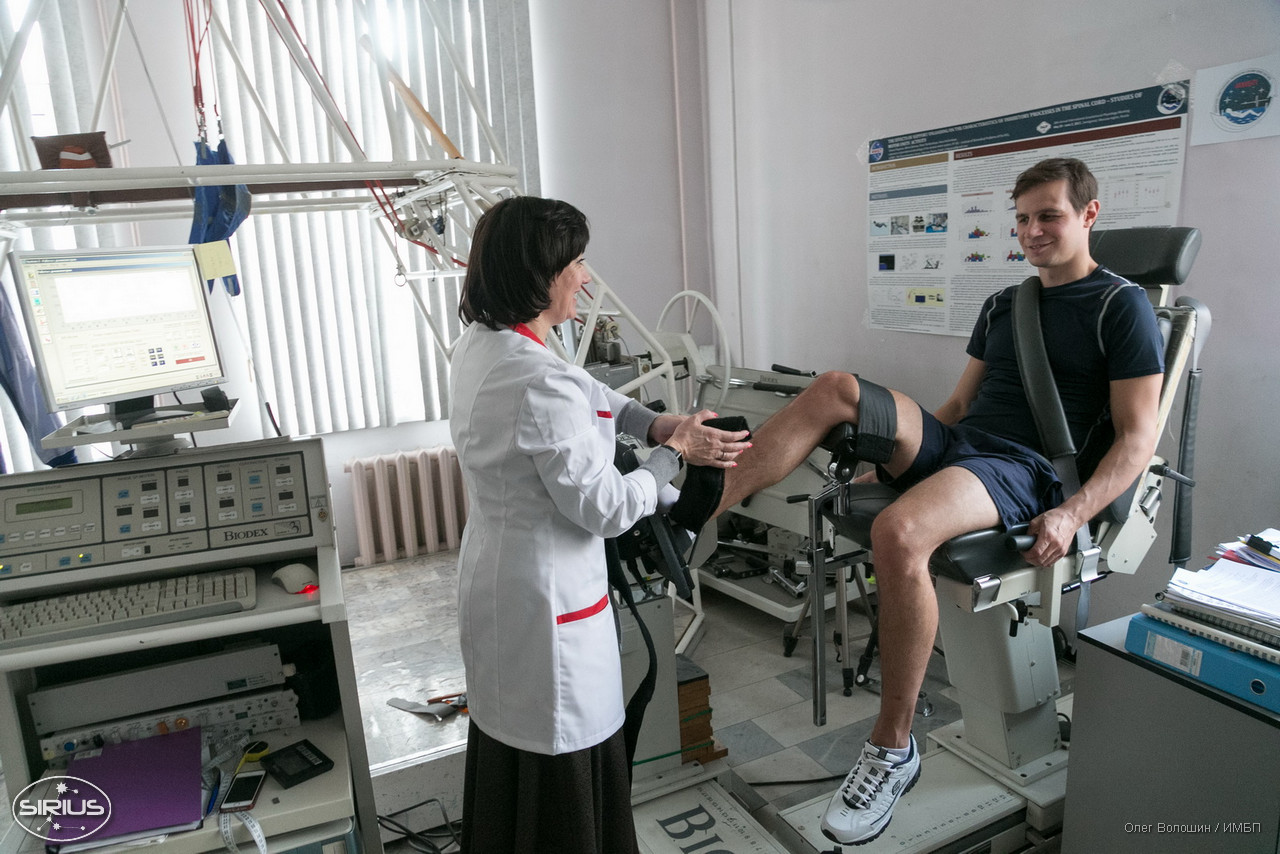
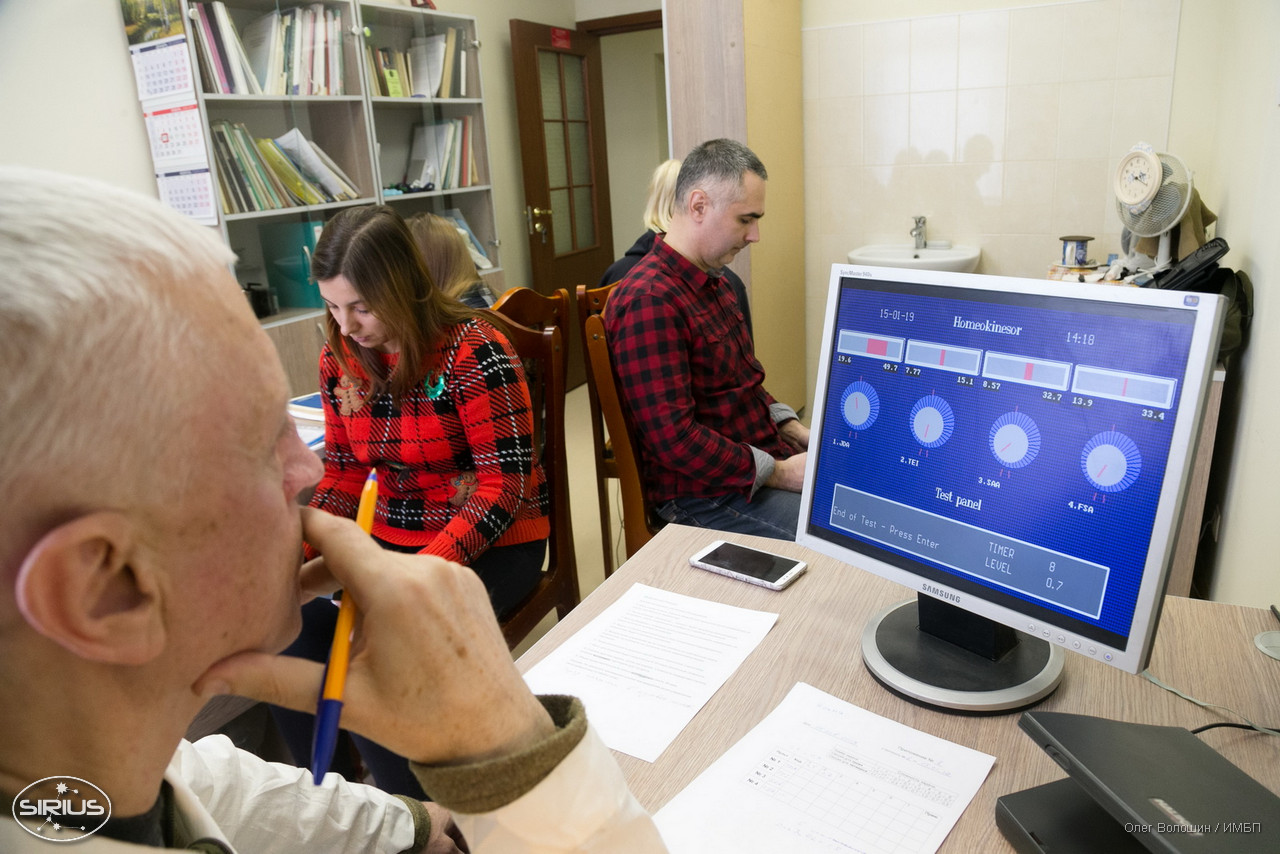
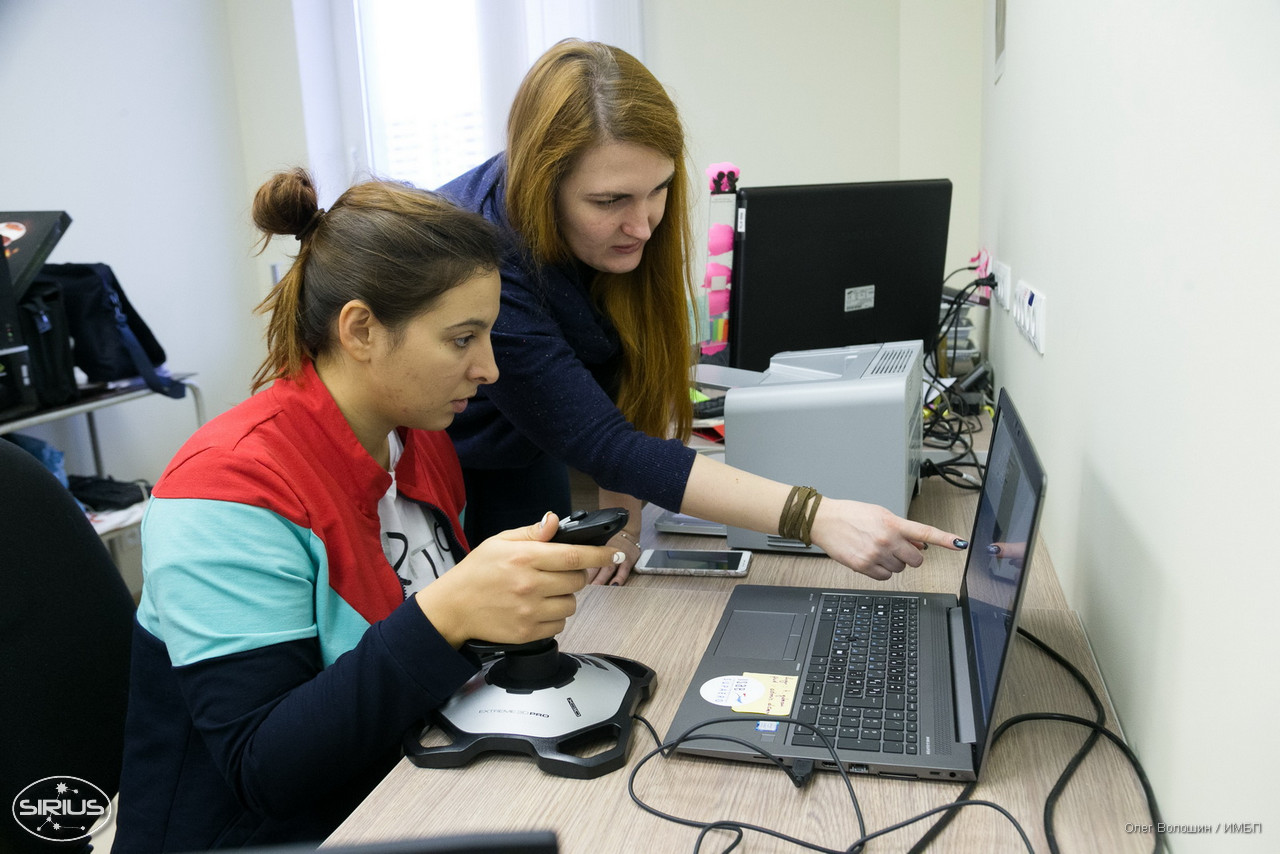
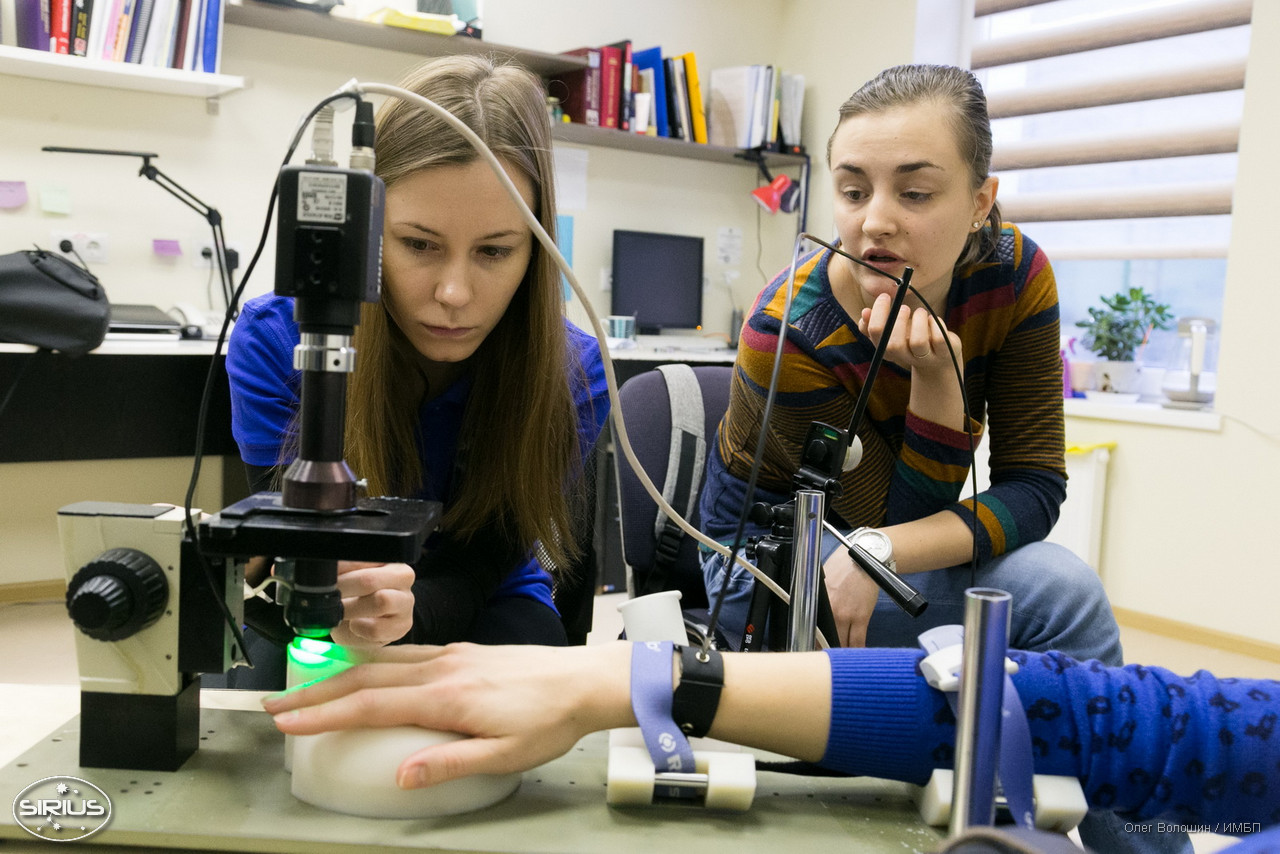
History of the project "SIRIUS-19"
August 01, 2018
The scientific program of the four-month isolation experiment "SIRIUS-18/19" was approved at a meeting of the Scientific Council of the SSC of the Russian Federation - IMBP RAS. In addition to Russian scientists, specialists from the USA, Germany, France, Italy, Belarus, Great Britain, Canada and the Czech Republic will take part in the program.
“The scientific program is in draft form. Now it has more than 450 pages, it has more than 70 scientific studies, ”explained the scientific coordinator of the experiment, Sergey Ponomarev. “Now work is under way to compile a cyclogram of the experiment. All studies need to be put in a four-month program. This issue is now being addressed by Russian and American specialists. I hope that in September the final version of the program will be formed, which will be held by biotic commissions in both Russia and the United States. ”
In the NASA application, there are about six studies in a four-month isolation experiment, and they are so extensive that if you break them down in directions, more than 20 experiments will be released. Discussion of joint Russian-American research will be held in September.
August 2, 2018.
“We plan that on January 15, 2019, preliminary studies will start, ten-day isolation will begin. On March 1, 2019, the crew of the expedition will enter the Ground Experimental Complex for four months of isolation. Transfers are possible, but within one or two days, everything is going according to plan, ”said Mark Belakovsky, general manager of the project, head of the department of the State Scientific Center of the Institute of Biomedical Problems (RAS).
The scientific coordinator of the experiment, Sergey Ponomarev, clarified that the preparation for the experiment is proceeding on schedule, almost all the equipment necessary for the SIRIUS experiment is already in place. “It remains only to adapt some of the software systems, to bring some of the equipment from other countries, but by 90% everything is ready,” he said.
Mark Belakovsky also informed that about 70 candidates applied for participation in the experiment. "To date, approximately 50 Russians and 20 foreigners from the USA, France, Belarus, and India have expressed a desire to take part in the SIRIUS experiment." So far, there is no firm agreement on how many foreign participants will be in the experiment, but three candidates have already expressed a desire to take part in an eight-month isolation experiment, which is scheduled for early 2020.
October 8, 2018.
NASA invites US-speaking US citizens to participate in the SIRIUS project, which starts next year in the Russian Federation, simulating a six-man crew flight into space. The US space agency expects to complete the selection of participants by early November.
In addition to American citizenship, candidates must have a number of characteristics: age 30-55 years old, not more than 180 centimeters tall, weight restrictions, good health. The applicant must also speak not only oral Russian and English, but also be able to write, the presence of flight military training, scientific or technical education is welcomed.
December 7, 2018.
In the period from December 04 to December 6, 2018, the operability of the medical-technical ground-based experimental complex (NEC) of IBMP was checked. The purpose of the test was to determine the readiness of the complex after its modernization for the 4-month experiment "SIRIUS 18/19".
Works performed at NEC in preparation for conducting experiments on the SIRIUS program:
The EU-50, EU-100, EU-150, EU-250 modules with all life support systems, including the newly created systems of LED dynamic lighting and digital video surveillance, passed the test.
The NEC operability test and evaluation of the equipment placed in the modules was carried out by a group of testers (commander - cosmonaut, Hero of Russia EI Tarelkin), who were in a sealed complex for 2 days.
As a result of the audit, it was established that the medical-technical complex, life support systems, ground control center and service systems are fully operational and ready for the SIRIUS 18/19 experiment.
January 30, 2019.
The start of the SIRIUS-19 model insulation experiment is scheduled for March 19, 2019.
The main and backup crew consists of pilot-cosmonaut Yevgeny Tarelkin, Polina Kuznetsova, Anastasia Stepanova, Darya Zidova, Artem Knyazev, Dmitry Glukhikh, Stefania Fedyai (all - Russia), Daniil Dubari (Republic of Belarus), Reinhold Poviljaitisa (Reinhold Pivilovi-iphiolaus), Daniil Doubari (Republic of Belarus), Reinhold Poviljaitisa (Reinhold Pivilov Ichilov). started background research and training sessions. The arrival of another crew member - Allen Mirkadyrov (Allen Mirkadyrov, USA) is expected in the coming days.
February 25, 2019.
The scientific program of the experiment "SIRIUS-19"
Currently, at the international level, issues related to the development of near and far space objects are being addressed, options for flying to the Moon and the Moon, the construction of orbital lunar stations, and planetary bases are being considered. Mankind is preparing to make a super-long flight to Mars.
To accomplish such ambitious tasks, an integrated modern system of medical and biological flight support is required, which has been developed in ground-based model experiments and on board the international space station (ISS).
The four-month isolation experiment “SIRIUS-19” is carried out within the framework of the international project “SIRIUS” (a joint project of the SSC of the Russian Federation - IBMP RAS and HRP NASA with the participation of the space agencies DLR and CNES, as well as specialized organizations of the space industry from Russia, USA, France, Germany, Italy, Belgium, Belarus and other countries) and is one of the stages of preparation for the development of deep space.
The main objective of the SIRIUS-19 experiment is to study the adaptation mechanisms of the human body to the conditions of 120-day isolation in a germobject with an artificial habitat simulating a space flight with the development and testing of various means of preventing the negative effect of a complex of insulating factors.
The main objectives of the project:
March 11, 2019.
At the meeting of the credentials committee for the selection of test volunteers to the international isolation model experiment “SIRIUS-19”, chaired by Academician Orlov OI, Director of the State Research Center of the Russian Federation - IBMP RAS The question of the distribution of functional duties among the crew members was considered.
By the decision of the credentials committee, it is accepted to approve Evgeny Igorevich Tarelkin as a test crew commander, Djarova ipravkaevyeevna test engineer-flight engineer, Stephanie Olegovna Test engineer, Crew tester-doctor Povilaitis Reinhold (Reinhold Povilaitis), test researcher, Stepanova Apov Reyhold tester, Reinhold Povilaitis test-researcher, Stepanova Aryan Reyhold tester (Reinhold Povilaitis) ) a test researcher. Dubar Daniil Aleksandrovich and Kuznetsova Polina Grigorievna were appointed doubles.
March 19, 2019.
On March 19, 2019, the 120-day isolation experiment SIRIUS-19 was launched at the State Scientific Center of the Institute for Biomedical Problems (IMBP) of the Russian Academy of Sciences, conducted jointly by SSC RF - IMBP RAS and NASA HRP in cooperation with partner organizations with a wide participation of specialists from Russia, USA, Germany, France, Italy, Belgium, Belarus and other countries.
Going beyond the Earth's orbit and conducting manned research of the nearest objects of the Solar System (with the prospect of creating extraterrestrial orbital complexes and planetary bases) is a new stage in human exploration of outer space. It requires solving the technical, physiological and psychological problems that the crew may encounter during the trip.
It is necessary to better study all possible risks of a long-term space expedition, as well as to develop biological and psychological technologies for the diagnosis, prevention and treatment of astronauts and astronauts.
All these factors are fully studied in the framework of the international project "SIRIUS" - Scientific International Research In Unique Terrestrial Station (Scientific international research in a unique ground complex), which includes a series of isolation experiments with durations of 4, 8 and 12 months for five years.
SIRIUS is a continuation of the medical and psychological research begun in the Mars-500 project and the current development strategy of Russian manned spacecraft in preparation for the development of deep space for work on board a circumluminal orbital station.
The proposed scientific program is also a continuation of the NASA HRP mission to provide space exploration beyond low-Earth orbit, which will reduce the risks to human health and health through a targeted program of basic, applied and operational research that promotes the development and maintenance of human health standards and preventive measures.
The SIRIUS-19 experiment scenario is aimed at choosing a place for a future lunar settlement and will reproduce the main characteristics of a real space flight to the moon, including operations in orbit and on the surface of the moon.
During the mission, the crew will perform tasks related to space flight operations, such as daily medical monitoring and in-depth health assessment, regular physical training and events corresponding to the flight scenario.
In addition, the crew will carry out a research program in physiology and psychology to study the effect of isolation in a confined space on human psychology and physiology and group relationships, with the aim of assisting in preparing for a long-term space research mission.
The scientific program of the four-month isolation experiment "SIRIUS-18/19" was approved at a meeting of the Scientific Council of the SSC of the Russian Federation - IMBP RAS. In addition to Russian scientists, specialists from the USA, Germany, France, Italy, Belarus, Great Britain, Canada and the Czech Republic will take part in the program.
“The scientific program is in draft form. Now it has more than 450 pages, it has more than 70 scientific studies, ”explained the scientific coordinator of the experiment, Sergey Ponomarev. “Now work is under way to compile a cyclogram of the experiment. All studies need to be put in a four-month program. This issue is now being addressed by Russian and American specialists. I hope that in September the final version of the program will be formed, which will be held by biotic commissions in both Russia and the United States. ”
In the NASA application, there are about six studies in a four-month isolation experiment, and they are so extensive that if you break them down in directions, more than 20 experiments will be released. Discussion of joint Russian-American research will be held in September.
August 2, 2018.
“We plan that on January 15, 2019, preliminary studies will start, ten-day isolation will begin. On March 1, 2019, the crew of the expedition will enter the Ground Experimental Complex for four months of isolation. Transfers are possible, but within one or two days, everything is going according to plan, ”said Mark Belakovsky, general manager of the project, head of the department of the State Scientific Center of the Institute of Biomedical Problems (RAS).
The scientific coordinator of the experiment, Sergey Ponomarev, clarified that the preparation for the experiment is proceeding on schedule, almost all the equipment necessary for the SIRIUS experiment is already in place. “It remains only to adapt some of the software systems, to bring some of the equipment from other countries, but by 90% everything is ready,” he said.
Mark Belakovsky also informed that about 70 candidates applied for participation in the experiment. "To date, approximately 50 Russians and 20 foreigners from the USA, France, Belarus, and India have expressed a desire to take part in the SIRIUS experiment." So far, there is no firm agreement on how many foreign participants will be in the experiment, but three candidates have already expressed a desire to take part in an eight-month isolation experiment, which is scheduled for early 2020.
October 8, 2018.
NASA invites US-speaking US citizens to participate in the SIRIUS project, which starts next year in the Russian Federation, simulating a six-man crew flight into space. The US space agency expects to complete the selection of participants by early November.
In addition to American citizenship, candidates must have a number of characteristics: age 30-55 years old, not more than 180 centimeters tall, weight restrictions, good health. The applicant must also speak not only oral Russian and English, but also be able to write, the presence of flight military training, scientific or technical education is welcomed.
December 7, 2018.
In the period from December 04 to December 6, 2018, the operability of the medical-technical ground-based experimental complex (NEC) of IBMP was checked. The purpose of the test was to determine the readiness of the complex after its modernization for the 4-month experiment "SIRIUS 18/19".
Works performed at NEC in preparation for conducting experiments on the SIRIUS program:
- The LED developed biorhythmic controlled lighting system was developed and installed in all experimental installations of the NEC to ensure the optimal psycho-physiological state of a person;
- a digital video surveillance system was designed and installed, consisting of 84 cameras, of which 66 cameras were installed inside the premises of all experimental installations and a simulator of the planet's surface;
- in order to improve safety, the system for maintaining the atmospheric composition in experimental facilities (EC) has been improved; a system for supplying oxygen and nitrogen to the EC with the help of appropriate generators was developed and installed;
- In accordance with the objectives of the experiment, an internal secure digital network is installed in each module;
- for greater confidence in the landing and work in space suits created an imitation of the lunar surface.
The EU-50, EU-100, EU-150, EU-250 modules with all life support systems, including the newly created systems of LED dynamic lighting and digital video surveillance, passed the test.
The NEC operability test and evaluation of the equipment placed in the modules was carried out by a group of testers (commander - cosmonaut, Hero of Russia EI Tarelkin), who were in a sealed complex for 2 days.
As a result of the audit, it was established that the medical-technical complex, life support systems, ground control center and service systems are fully operational and ready for the SIRIUS 18/19 experiment.
January 30, 2019.
The start of the SIRIUS-19 model insulation experiment is scheduled for March 19, 2019.
The main and backup crew consists of pilot-cosmonaut Yevgeny Tarelkin, Polina Kuznetsova, Anastasia Stepanova, Darya Zidova, Artem Knyazev, Dmitry Glukhikh, Stefania Fedyai (all - Russia), Daniil Dubari (Republic of Belarus), Reinhold Poviljaitisa (Reinhold Pivilovi-iphiolaus), Daniil Doubari (Republic of Belarus), Reinhold Poviljaitisa (Reinhold Pivilov Ichilov). started background research and training sessions. The arrival of another crew member - Allen Mirkadyrov (Allen Mirkadyrov, USA) is expected in the coming days.
February 25, 2019.
The scientific program of the experiment "SIRIUS-19"
Currently, at the international level, issues related to the development of near and far space objects are being addressed, options for flying to the Moon and the Moon, the construction of orbital lunar stations, and planetary bases are being considered. Mankind is preparing to make a super-long flight to Mars.
To accomplish such ambitious tasks, an integrated modern system of medical and biological flight support is required, which has been developed in ground-based model experiments and on board the international space station (ISS).
The four-month isolation experiment “SIRIUS-19” is carried out within the framework of the international project “SIRIUS” (a joint project of the SSC of the Russian Federation - IBMP RAS and HRP NASA with the participation of the space agencies DLR and CNES, as well as specialized organizations of the space industry from Russia, USA, France, Germany, Italy, Belgium, Belarus and other countries) and is one of the stages of preparation for the development of deep space.
The main objective of the SIRIUS-19 experiment is to study the adaptation mechanisms of the human body to the conditions of 120-day isolation in a germobject with an artificial habitat simulating a space flight with the development and testing of various means of preventing the negative effect of a complex of insulating factors.
The main objectives of the project:
- to assess the effect of long-term isolation of a person in a germobject on the psychological and psycho-physiological state, mental and physical performance, as well as on the basic physiological systems of the body;
- provide monitoring of the health status of testers, as well as the environmental parameters and sanitary and hygienic conditions of isolation;
- to test experimental equipment in the germobject that is available and being prepared for delivery onboard the ISS;
- to assess the adequacy of the isolation model in comparison with the real space flight as it is based on the various physiological systems of the body;
- create an integrated database of scientific data obtained during the implementation of the project;
- conduct research cooperation between various research centers at the international level;
- to work out mechanisms for the creation and functioning of international cooperation, which is responsible for setting the scientific tasks of promising flights to the moon;
- to gain experience in implementation and a scientific and organizational basis for subsequent joint long-term isolation experiments with a mixed crew.
- The total number of experiments is 79 (psychology - 27, physiology - 24, immunity - 5, metabolism - 9, microbiology and hygiene - 12, telemedicine - 2).
March 11, 2019.
At the meeting of the credentials committee for the selection of test volunteers to the international isolation model experiment “SIRIUS-19”, chaired by Academician Orlov OI, Director of the State Research Center of the Russian Federation - IBMP RAS The question of the distribution of functional duties among the crew members was considered.
By the decision of the credentials committee, it is accepted to approve Evgeny Igorevich Tarelkin as a test crew commander, Djarova ipravkaevyeevna test engineer-flight engineer, Stephanie Olegovna Test engineer, Crew tester-doctor Povilaitis Reinhold (Reinhold Povilaitis), test researcher, Stepanova Apov Reyhold tester, Reinhold Povilaitis test-researcher, Stepanova Aryan Reyhold tester (Reinhold Povilaitis) ) a test researcher. Dubar Daniil Aleksandrovich and Kuznetsova Polina Grigorievna were appointed doubles.
March 19, 2019.
On March 19, 2019, the 120-day isolation experiment SIRIUS-19 was launched at the State Scientific Center of the Institute for Biomedical Problems (IMBP) of the Russian Academy of Sciences, conducted jointly by SSC RF - IMBP RAS and NASA HRP in cooperation with partner organizations with a wide participation of specialists from Russia, USA, Germany, France, Italy, Belgium, Belarus and other countries.
Going beyond the Earth's orbit and conducting manned research of the nearest objects of the Solar System (with the prospect of creating extraterrestrial orbital complexes and planetary bases) is a new stage in human exploration of outer space. It requires solving the technical, physiological and psychological problems that the crew may encounter during the trip.
It is necessary to better study all possible risks of a long-term space expedition, as well as to develop biological and psychological technologies for the diagnosis, prevention and treatment of astronauts and astronauts.
All these factors are fully studied in the framework of the international project "SIRIUS" - Scientific International Research In Unique Terrestrial Station (Scientific international research in a unique ground complex), which includes a series of isolation experiments with durations of 4, 8 and 12 months for five years.
SIRIUS is a continuation of the medical and psychological research begun in the Mars-500 project and the current development strategy of Russian manned spacecraft in preparation for the development of deep space for work on board a circumluminal orbital station.
The proposed scientific program is also a continuation of the NASA HRP mission to provide space exploration beyond low-Earth orbit, which will reduce the risks to human health and health through a targeted program of basic, applied and operational research that promotes the development and maintenance of human health standards and preventive measures.
The SIRIUS-19 experiment scenario is aimed at choosing a place for a future lunar settlement and will reproduce the main characteristics of a real space flight to the moon, including operations in orbit and on the surface of the moon.
During the mission, the crew will perform tasks related to space flight operations, such as daily medical monitoring and in-depth health assessment, regular physical training and events corresponding to the flight scenario.
In addition, the crew will carry out a research program in physiology and psychology to study the effect of isolation in a confined space on human psychology and physiology and group relationships, with the aim of assisting in preparing for a long-term space research mission.
Draft concept of a series of model experiments based on NIBP with international participation
The overall goal of the program:
The National Aeronautics and Space Administration (NASA) and the State Research Center Institute for Biomedical Problems of the Russian Academy of Sciences (IBMP) have a long and successful history of collaborating on joint research related to human health and well-being. space. Both NASA HRP (Human Research Program) and IBMP are conducting research to identify preventive measures and technologies to protect the health of astronauts and cosmonauts during space flight.
Based on this common task, collaboration between NASA HRP and IBMP presents opportunities for collaborative research on scientific issues to facilitate the experimentation of each of these organizations and the cooperation of partner organizations. NASA HRP and IBMP propose to use controlled, isolated environmental conditions for conducting research on human psychology and human performance, in order to support research aboard the International Space Station (ISS), as well as to reduce risks in space interplanetary missions.
Medico-Technical Ground Experimental Complex (NEC) IBMP has unique means for conducting model studies of space flight. NEC is an analog platform with multifunctional experimental segments capable of accommodating from 3 to 10 crew members.
Research conducted at the NEC usually requires isolation and a stable environment, which is provided by local life support systems, and is carried out over a long period in order to study the effect of isolation and enclosed space on the mental health of the objects of study.
NEC can be used to study life-support systems, space activities, medical prevention equipment, crew performance and dynamics, crew autonomy, effects of isolation, and associated physiological stressors. In addition, the NEC can provide unique resources, such as variable volume of residential compartments, special day-night cycles and innovative working environmental conditions for research in accordance with the needs of testers.
Thus, joint research at NEC provides a unique opportunity to effectively address the risks of manned space flight. NASA and IBMP unite the efforts of both organizations and are interested in consolidating with other international partners in the use of NEC for critical research related to psychological and physiological reactions to long-term isolation.
Understanding these reactions will provide information to joint research to develop prevention tools that reduce the undesirable effects of prolonged isolation. Successful means of prevention, developed in ground-based studies, will then be tested on the ISS to assess their effectiveness in order to use them in long-term orbital flights and the system of medical and biological support for promising interplanetary missions.
International project "SIRIUS":
These tasks will be fully studied in the framework of the international project "SIRIUS" - Scientific International Research In Unique Terrestrial Station (scientific research in a unique ground complex), conducted jointly by the Russian State Research Center Institute of Biomedical Problems of the Russian Academy of Sciences and the American Human Research Program NASA in cooperation with partner organizations with the broad participation of specialists from Russia, Italy, Germany, and other countries.
The program of the SIRIUS project is designed for a period of up to five years. During this time, it is planned to conduct a series of isolation experiments of approximately two to three weeks, four months, eight months and twelve months.
The proposed research program based on the NEC was developed on the basis of the proposed draft concept and strategy for the development of Russian manned space vehicles in the period up to 2035 and is a continuation of studies of medical and psychological risks in the Mars-500 project during long autonomous manned space flights and the operation of orbital and on the planetary bases.
Brief rationale for the approaches to the formation of the IBMP scientific program:
The long-term fruitful comprehensive studies of the health status, behavior and activities of crews in isolation, conducted in the USSR and Russia based on the needs of medical and psychological support of long-term space flights, were overwhelmingly focused on the study of test activity of a human operator.
Under the "test" activity refers to the implementation of various methods for assessing the state of health, physical, mental and professional performance. At the same time, the practically unexplored area remains the actual behavioral aspects of a person’s stay in conditions of limited volume, sensory deprivation of a person - that is, what happens between the test activity of the subjects and takes most of their life.
Without a thorough continuous study of the activity of the crew in artificial habitats, it is almost impossible to answer the questions of optimizing the size, layout, ergonomics, health standards, necessary prevention regimes and food resources for future interplanetary ships and planetary settlements. Without a behavioral analysis of crews of different composition and length of stay, the answers to these questions will be very approximate.
In part, the lack of comprehensive behavioral research was associated with a clear focus on the aspects of the operator’s professional readiness to perform the tasks, in part, with ethical restrictions. In addition, to solve these problems, there was an acute lack of methodological and instrumentation equipment - portable wearable wireless devices, which allow continuously and invasively register daily activity and location of the subjects examined in relation to each other and specific thermocamera objects.
In recent years, the development of computer technology has led to the emergence of wearable portable recorders-actigraphs, allowing not only to continuously record daily locomotor activity of a person, to determine the duration of rest periods and night sleep, but also to keep records of physiological parameters (pulse, skin resistance).
The tremendous opportunities that are opening up to scientists for their use have already prompted NASA to collect data on the astronauts' daily activity, duration, and sleep quality (for example, the “Sleep” experiment). Similar studies to collect background information regarding microgravity conditions were carried out by Americans and ESA in the Mars 500 project and continued in the Hera project.
In addition, over the past three years, various countries (Russia, Germany, USA) have developed portable wearable sensors for positioning a person in a hermetic volume. They make it possible not only to determine the coordinates of a person in a confined space, but also the direction of his gaze, the relative position of people and objects at each moment of working and free time. During sleep, it became possible to record body position and motor activity, which complements the traditional registration of heart rate, ECG, blood pressure and allows you to assess the quality of sleep.
The combination of the described technologies will allow to conduct a full-scale analysis of the behavior of the crew that is mixed in gender composition in the containment under prolonged influence on the body and psyche of limited space, sensory deprivation, monotony and limited communication with the outside world. The significance of such work can hardly be overestimated in the light of space crews' upcoming projects for flights of mixed crews and deployment of bases on other planets.
Another important area of research is to work out in ground conditions abnormal situations that may arise in real space flight. In this regard, there are several important tasks:
1. Providing qualified assistance to non-specialists in cases where, for a number of reasons, the crew doctor cannot perform this function. The described situation requires careful study on the ground and the development of certain algorithms of the crew in emergency medical situations, including the use of telemedicine technologies.
2. The action of the crew in the event of various kinds of technical malfunctions that can lead to an accident with serious consequences that threaten the life and health of crew members. In this regard, it is advisable to comprehensively study the effect of stress on behavior, performance, as well as the physiological and psychological state of health of volunteers, testers, to develop instructions and recommendations for the crew’s actions in emergency situations, and also to develop a system of tests that would determine the relationship between individual stress tolerance and health . The information obtained during the execution of these tests could not only help in drawing up algorithms for the crew’s actions in an extreme situation (for example, it is personalized to dose the shift time of an on-board engineer who fixes a technical problem), but also to compile individual workload graphs depending on the psycho-physiological reserves of the body.
Project tasks:
, , , - , :
:
The National Aeronautics and Space Administration (NASA) and the State Research Center Institute for Biomedical Problems of the Russian Academy of Sciences (IBMP) have a long and successful history of collaborating on joint research related to human health and well-being. space. Both NASA HRP (Human Research Program) and IBMP are conducting research to identify preventive measures and technologies to protect the health of astronauts and cosmonauts during space flight.
Based on this common task, collaboration between NASA HRP and IBMP presents opportunities for collaborative research on scientific issues to facilitate the experimentation of each of these organizations and the cooperation of partner organizations. NASA HRP and IBMP propose to use controlled, isolated environmental conditions for conducting research on human psychology and human performance, in order to support research aboard the International Space Station (ISS), as well as to reduce risks in space interplanetary missions.
Medico-Technical Ground Experimental Complex (NEC) IBMP has unique means for conducting model studies of space flight. NEC is an analog platform with multifunctional experimental segments capable of accommodating from 3 to 10 crew members.
Research conducted at the NEC usually requires isolation and a stable environment, which is provided by local life support systems, and is carried out over a long period in order to study the effect of isolation and enclosed space on the mental health of the objects of study.
NEC can be used to study life-support systems, space activities, medical prevention equipment, crew performance and dynamics, crew autonomy, effects of isolation, and associated physiological stressors. In addition, the NEC can provide unique resources, such as variable volume of residential compartments, special day-night cycles and innovative working environmental conditions for research in accordance with the needs of testers.
Thus, joint research at NEC provides a unique opportunity to effectively address the risks of manned space flight. NASA and IBMP unite the efforts of both organizations and are interested in consolidating with other international partners in the use of NEC for critical research related to psychological and physiological reactions to long-term isolation.
Understanding these reactions will provide information to joint research to develop prevention tools that reduce the undesirable effects of prolonged isolation. Successful means of prevention, developed in ground-based studies, will then be tested on the ISS to assess their effectiveness in order to use them in long-term orbital flights and the system of medical and biological support for promising interplanetary missions.
International project "SIRIUS":
These tasks will be fully studied in the framework of the international project "SIRIUS" - Scientific International Research In Unique Terrestrial Station (scientific research in a unique ground complex), conducted jointly by the Russian State Research Center Institute of Biomedical Problems of the Russian Academy of Sciences and the American Human Research Program NASA in cooperation with partner organizations with the broad participation of specialists from Russia, Italy, Germany, and other countries.
The program of the SIRIUS project is designed for a period of up to five years. During this time, it is planned to conduct a series of isolation experiments of approximately two to three weeks, four months, eight months and twelve months.
The proposed research program based on the NEC was developed on the basis of the proposed draft concept and strategy for the development of Russian manned space vehicles in the period up to 2035 and is a continuation of studies of medical and psychological risks in the Mars-500 project during long autonomous manned space flights and the operation of orbital and on the planetary bases.
Brief rationale for the approaches to the formation of the IBMP scientific program:
The long-term fruitful comprehensive studies of the health status, behavior and activities of crews in isolation, conducted in the USSR and Russia based on the needs of medical and psychological support of long-term space flights, were overwhelmingly focused on the study of test activity of a human operator.
Under the "test" activity refers to the implementation of various methods for assessing the state of health, physical, mental and professional performance. At the same time, the practically unexplored area remains the actual behavioral aspects of a person’s stay in conditions of limited volume, sensory deprivation of a person - that is, what happens between the test activity of the subjects and takes most of their life.
Without a thorough continuous study of the activity of the crew in artificial habitats, it is almost impossible to answer the questions of optimizing the size, layout, ergonomics, health standards, necessary prevention regimes and food resources for future interplanetary ships and planetary settlements. Without a behavioral analysis of crews of different composition and length of stay, the answers to these questions will be very approximate.
In part, the lack of comprehensive behavioral research was associated with a clear focus on the aspects of the operator’s professional readiness to perform the tasks, in part, with ethical restrictions. In addition, to solve these problems, there was an acute lack of methodological and instrumentation equipment - portable wearable wireless devices, which allow continuously and invasively register daily activity and location of the subjects examined in relation to each other and specific thermocamera objects.
In recent years, the development of computer technology has led to the emergence of wearable portable recorders-actigraphs, allowing not only to continuously record daily locomotor activity of a person, to determine the duration of rest periods and night sleep, but also to keep records of physiological parameters (pulse, skin resistance).
The tremendous opportunities that are opening up to scientists for their use have already prompted NASA to collect data on the astronauts' daily activity, duration, and sleep quality (for example, the “Sleep” experiment). Similar studies to collect background information regarding microgravity conditions were carried out by Americans and ESA in the Mars 500 project and continued in the Hera project.
In addition, over the past three years, various countries (Russia, Germany, USA) have developed portable wearable sensors for positioning a person in a hermetic volume. They make it possible not only to determine the coordinates of a person in a confined space, but also the direction of his gaze, the relative position of people and objects at each moment of working and free time. During sleep, it became possible to record body position and motor activity, which complements the traditional registration of heart rate, ECG, blood pressure and allows you to assess the quality of sleep.
The combination of the described technologies will allow to conduct a full-scale analysis of the behavior of the crew that is mixed in gender composition in the containment under prolonged influence on the body and psyche of limited space, sensory deprivation, monotony and limited communication with the outside world. The significance of such work can hardly be overestimated in the light of space crews' upcoming projects for flights of mixed crews and deployment of bases on other planets.
Another important area of research is to work out in ground conditions abnormal situations that may arise in real space flight. In this regard, there are several important tasks:
1. Providing qualified assistance to non-specialists in cases where, for a number of reasons, the crew doctor cannot perform this function. The described situation requires careful study on the ground and the development of certain algorithms of the crew in emergency medical situations, including the use of telemedicine technologies.
2. The action of the crew in the event of various kinds of technical malfunctions that can lead to an accident with serious consequences that threaten the life and health of crew members. In this regard, it is advisable to comprehensively study the effect of stress on behavior, performance, as well as the physiological and psychological state of health of volunteers, testers, to develop instructions and recommendations for the crew’s actions in emergency situations, and also to develop a system of tests that would determine the relationship between individual stress tolerance and health . The information obtained during the execution of these tests could not only help in drawing up algorithms for the crew’s actions in an extreme situation (for example, it is personalized to dose the shift time of an on-board engineer who fixes a technical problem), but also to compile individual workload graphs depending on the psycho-physiological reserves of the body.
Project tasks:
, , , - , :
- ( , , ) . - , .
- – ( ).
- ( ) , () .
- ( ) , . () , – , -, .
- ( , ) – , . , – .
- , ( ) , , .
- , .
- , , , «» .
- , , .
- , -, , , , .
- .
- ( ) .
- , , , .
- .
:
- - , .
- .
- , .
- , , .
- .
- , .
- , .
SIRIUS-19
Overview
4- /NASA SIRIUS. , .
4- , , .
, , - .
(), , , .
, , , . . .
.
— 4 :
, 3 3 . , , 2 .
Crew:
1. .
2. , , , .
3. :
4. , .
5. , /.
6. .
7. .
, 16 , 8 ( ); , , , , .
8 .
, . , .
: :
: , , .
:
: , , , , , , , .
, , IRD :
Purpose of the mission: maintenance of ship systems.
: - .
: , , .
4- /NASA SIRIUS. , .
4- , , .
, , - .
(), , , .
, , , . . .
- , ( DEEP SPACE GATEWAY).
- 2- , .
- , 2 3 . , .
- .
- , ( ), .
- .
.
— 4 :
- : 3 + 7 .
- . : 7 .
- : 10 .
- . : 7 + 3 .
- . : 4 .
- : 7 + 3 .
, 3 3 . , , 2 .
Crew:
- .
- .
- .
- №1.
- №2.
- №3.
1. .
- .
- (, , ).
- - .
- , .
2. , , , .
3. :
- 5 .
- 5 , .
4. , .
5. , /.
6. .
7. .
, 16 , 8 ( ); , , , , .
8 .
, . , .
: :
- .
- .
- .
- .
- . .
: , , .
:
- ( .., ) .
- .
- .
- .
: , , , , , , , .
, , IRD :
- ( ) .
- , .
- . , . .
- . , .
. - , .
- , , , .
Purpose of the mission: maintenance of ship systems.
- : .
- : - .
- : , , , .
- : .
: - .
: , , .
120- «SIRIUS-19»
Tarelkin Evgeny Igorevich - Pilot-Cosmonaut of the Russian Federation, Hero of the Russian Federation, Lieutenant Colonel of the Air Force of the reserve.
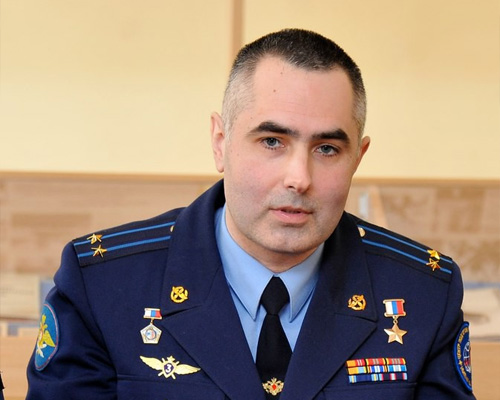
Yevgeny Igorevich Tarelkin was born on December 29, 1974 in the village of Pervomaiskoye, Chita Region (now the Trans-Baikal Territory) in the family of a test-parachute jumper, the future Hero of the Russian Federation I. E. Tarelkin. After studying at school No. 14 named after Yu. A. Gagarin of the Schelkovsky District of the Moscow Region, in 1992 he entered the Yeisk Higher Military Aviation School for Pilots. V.M. Komarov. In 1998 he graduated from the Yu.A. Air Force Academy. Gagarin, specialty "Operation of air transport and air traffic control."
Since 1998, he served in the RGNII TsPK them. Yu.A. Gagarin, became a test engineer of the 3rd class, an instructor of parachute training (more than 800 parachute jumps), a pilot with a total flying time of more than 300 hours, a professional diver (spent about 250 hours under water). Evgeny Igorevich is a candidate for master of sports in parachuting, qualified as an assistant PADI instructor (Professional Association of Diving Instructors - professional association of diving instructors).
In 2003, after undergoing a medical examination at the Institute of Biomedical Problems, at the meeting of the Interdepartmental Commission for the Selection of Cosmonauts, he was admitted to the cosmonaut corps for general space training, which he completed in June 2005, passing state exams with an excellent mark.
At the meeting of the Interdepartmental Qualification Commission on July 5, 2005, Evgeny Igorevich Tarelkin was qualified as a test cosmonaut. In May 2006, seconded to the Space Center. Johnson (USA) as a representative of the CPC.
In 2012, at the meeting of the State Commission for the flight tests of manned space complexes was approved in the main crew of the ISS 34/35 expedition. Started on October 23, 2012 as a flight engineer of the Soyuz TMA-06M spacecraft and a flight engineer of the ISS main crew, along with Oleg Novitsky and Kevin Ford (astronaut NASA).
The flight duration was 143 days 16 hours. Shortly after landing, on March 16, 2013, together with Oleg Novitsky, he took part in an experiment to work out a manual, controlled descent from orbit to the surface of Mars using the centrifuge TsF-18, which simulated congestion during descent in real space flight mode.
Currently, Evgeny Igorevich works at the Institute of Biomedical Problems of the Russian Academy of Sciences.
Zhidova Daria Alekseevna - engineer of the SP Korolev Rocket and Space Corporation Energia.
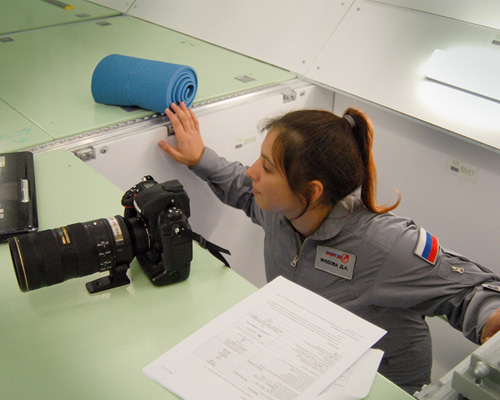
Daria Alekseevna was born in 1989 in the city of Tomsk. After graduating from high school (with a silver medal) she entered the Tomsk State University in the Faculty of Physics and Technology. In 2013 she received a master's degree in "Technical Physics" with the award of a diploma with honors. Is the best graduate of the city of Tomsk in the nomination "Excellence" 2013. Upon graduation, Darya Alekseevna began working as a design engineer at RSC Energia in the design department for oxygen engines and propulsion systems. From 2016 to the present, he has been working as an engineer in the Flight Test Department of the RSC Energia.
Daria Alekseevna Zhidova - participant and multiple winner of scientific conferences and seminars, has scientific papers. The owner of the third category in mountaineering and the third category in climbing. Repeatedly won prizes, both in personal and in team competitions in orienteering, rescue and rock climbing.
In the Flight Test Department, Darya Alekseevna is directly involved in the design and testing of promising manned equipment (PTK Federation, the Scientific and Energy Module of the RS ISS (LEM), the Lunar Takeoff and Landing Complex (LISP) and other products created as part of "Lunar Program"), performs organizational and technical work on the maintenance of contracts with the State Research Center of the Russian Federation - IMBP RAS, Research Institute of Central Training Courses of them. Yu.A. Gagarin and other organizations of the space industry in the framework of current and future projects of the corporation "Energy".
Allen Mirkadyrov - Associate Branch Head, Department of Goddard Space Flight Center (GSFC) telecommunications networks and technologies.

He holds a master's degree from San Diego State University, and a specialty is aerospace engineering.
As deputy branch manager, oversees numerous projects involving employees of the Goddard Space Flight Center (near-earth network (NEN) project, space network (SN), search and rescue (SAR), laser communications retransmission demonstration (LCRD) , network integration management (NIMO), satellite tracking and data relay (TDRS)).
In addition, it performs the necessary technical and administrative tasks, manages the work of the contractor, carries out budgetary supervision and many other functions.
A crew member of the 240-day isolation experiment HI-SEAS III conducted on the slopes of the Mauna Loa volcano on the island of Hawaii. The American project HI-SEAS is being conducted under the control of the University of Hawaii with the participation of Cornell University, commissioned by NASA, and simulates the conditions in which the members of the future Martian expedition find themselves.
Stepanova Anastasia Alekseevna (Russia) - test tester.
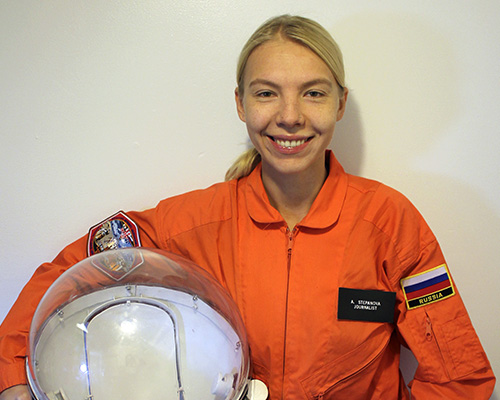
Anastasia Stepanova was born on March 9, 1986 in the Tashkent city of the Uzbek SSR. In 2002, after graduating from the 9th grade of secondary school No. 19, she completed a four-month English course at the American College (Dublin, Ireland). Completed secondary education in grades 10-11 of the Rangitoto College School in Auckland, New Zealand.
In 2010 she graduated from the Moscow State University named after M.V. Lomonosov (graduate work "Space journalism" was led by Russian cosmonaut Y.M. Baturin). In 2015, for the second higher education she entered the Moscow State Technical University named after N.E. Bauman on the faculty of "Special Engineering", the department of "Robotic systems and mechatronics."
In 2014, for two weeks as part of a Russian crew, she took part in an isolation experiment at a “Mars” research station in the Utah desert (Mars Desert Research Station, USA).
After the successful completion of the experiment, I got to the final of the program "Mars 160" from the American public organization "Martian Society" (The Mars Society - a non-profit organization founded by Robert Zubrin in 1998). In 2016, for 80 days, I participated in the first part of the Mars 160 international research experiment on modeling the conditions of a manned expedition to Mars at a station in the desert of Utah according to the Martian Society program.
She performed the duties of the crew responsible for the health and safety of the crew, microbiology assistant for the crew and, additionally, the crew historian journalist. On the instructions of the Institute for Biomedical Problems, she conducted psychological studies on the program “Cognitive psychology and psychology of small groups”.
In July 2017, the second 30-day part of the Mars 160 research experiment was held at the station of Devon Island of the Canadian Arctic Archipelago.
In 2015 - 2016, Anastasia Alekseevna was trained in the training program for reservist rescuers and was certified for the qualification "rescuer". In 2016, she worked as a member of the crew on duty at the Spas Rezerv Public Search and Rescue Team. She has a PADI diving certificate (Professional Association of Diving Instructors), in 2017 she performed three parachute jumps.
Currently, Stepanova Anastasia Alekseevna works as a junior researcher at the laboratory of cognitive psychology and psychology of small groups in the Department of Psychology, Neurophysiology and Psychophysiology of Operators of the Institute of Medical and Biological Problems of the Russian Academy of Sciences
Povilaitis Reinhold (Reinhold Povilaitis, USA) - test researcher.

Reinhold Povilaitis is an analyst of research and operations on the lunar reconnaissance orbiter (LRO).
He graduated from the University of Arizona (Arizona State University) with a master's degree in materials science and engineering and a graduate certificate in the field of nuclear energy.
Participant in the Earth Insulation Research Program Human Exploration Research Analog (HERA), which is implemented by NASA at the Lyndon Johnson Space Center in Houston. HERA simulates astronauts' on-planet residential module with the aim of studying the characteristics of human work and behavior in the conditions of a space mission.
Fedyay Stefania O. - psychiatrist and research physician, junior researcher of the IMBP RAS.
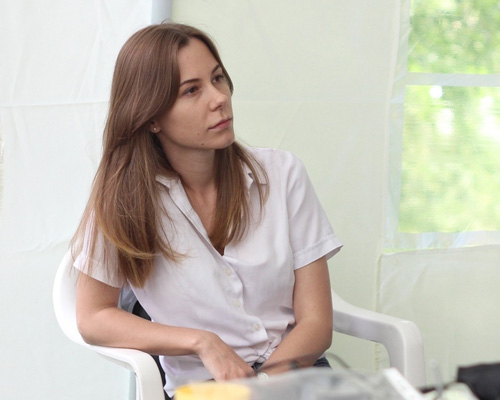
Stefania Olegovna was born in 1990 in the city of Frunze (currently Beshkek is the capital of Kyrgyzstan). After graduating from high school, she entered the Kyrgyz-Russian Slavic University in the Faculty of Medicine with a degree in General Medicine. After receiving the diploma of the Russian Federation with honors, she continued her studies in Moscow at the internship of the Russian University of Peoples Friendship (RUDN) at the Department of Psychiatry and Medical Psychology (specialty “Psychiatry”).
In 2016, she entered the postgraduate course of the Institute of Biomedical Research, Russian Academy of Sciences, in the department of psychophysiology, psychology and psychophysiology of the activities of operators (laboratory of cognitive psychology and psychology of small groups) in the specialty "Aviation, space and sea medicine".
Currently, Stefania O. successfully combines medical and scientific activities as a psychiatrist and research physician in the framework of clinical studies of the RUDN University with work at IBMP as a junior research assistant in the department of operational management of medical support for space flights. help in extreme conditions and telemedicine).
In 2018, she was directly involved as a researcher in the program for conducting a comprehensive ergonomic experiment on modeling crew’s on-board activities on an ergonomic model of the science and energy module (NEM MKS). Stefania Olegovna was the executive in charge of the Vulkan experiment (the study of daily motor activity and the quality of sleep of crew members in order to predict the psychophysiological state and operability of the operator) included in the research program of the SIRIUS-17 project. Included in the group of directors of the Algometria experiment (the study of pain sensitivity in humans in space flight conditions), which is currently being conducted onboard the ISS.
Stefania Fedyai is a regular participant in Russian and international conferences on psychiatry. The owner of a number of diplomas and certificates, including Good Clinical Practices (GCP - the international standard of ethical standards and quality of scientific research), has scientific papers. Candidate master of sports in rhythmic gymnastics.

Yevgeny Igorevich Tarelkin was born on December 29, 1974 in the village of Pervomaiskoye, Chita Region (now the Trans-Baikal Territory) in the family of a test-parachute jumper, the future Hero of the Russian Federation I. E. Tarelkin. After studying at school No. 14 named after Yu. A. Gagarin of the Schelkovsky District of the Moscow Region, in 1992 he entered the Yeisk Higher Military Aviation School for Pilots. V.M. Komarov. In 1998 he graduated from the Yu.A. Air Force Academy. Gagarin, specialty "Operation of air transport and air traffic control."
Since 1998, he served in the RGNII TsPK them. Yu.A. Gagarin, became a test engineer of the 3rd class, an instructor of parachute training (more than 800 parachute jumps), a pilot with a total flying time of more than 300 hours, a professional diver (spent about 250 hours under water). Evgeny Igorevich is a candidate for master of sports in parachuting, qualified as an assistant PADI instructor (Professional Association of Diving Instructors - professional association of diving instructors).
In 2003, after undergoing a medical examination at the Institute of Biomedical Problems, at the meeting of the Interdepartmental Commission for the Selection of Cosmonauts, he was admitted to the cosmonaut corps for general space training, which he completed in June 2005, passing state exams with an excellent mark.
At the meeting of the Interdepartmental Qualification Commission on July 5, 2005, Evgeny Igorevich Tarelkin was qualified as a test cosmonaut. In May 2006, seconded to the Space Center. Johnson (USA) as a representative of the CPC.
In 2012, at the meeting of the State Commission for the flight tests of manned space complexes was approved in the main crew of the ISS 34/35 expedition. Started on October 23, 2012 as a flight engineer of the Soyuz TMA-06M spacecraft and a flight engineer of the ISS main crew, along with Oleg Novitsky and Kevin Ford (astronaut NASA).
The flight duration was 143 days 16 hours. Shortly after landing, on March 16, 2013, together with Oleg Novitsky, he took part in an experiment to work out a manual, controlled descent from orbit to the surface of Mars using the centrifuge TsF-18, which simulated congestion during descent in real space flight mode.
Currently, Evgeny Igorevich works at the Institute of Biomedical Problems of the Russian Academy of Sciences.
Zhidova Daria Alekseevna - engineer of the SP Korolev Rocket and Space Corporation Energia.

Daria Alekseevna was born in 1989 in the city of Tomsk. After graduating from high school (with a silver medal) she entered the Tomsk State University in the Faculty of Physics and Technology. In 2013 she received a master's degree in "Technical Physics" with the award of a diploma with honors. Is the best graduate of the city of Tomsk in the nomination "Excellence" 2013. Upon graduation, Darya Alekseevna began working as a design engineer at RSC Energia in the design department for oxygen engines and propulsion systems. From 2016 to the present, he has been working as an engineer in the Flight Test Department of the RSC Energia.
Daria Alekseevna Zhidova - participant and multiple winner of scientific conferences and seminars, has scientific papers. The owner of the third category in mountaineering and the third category in climbing. Repeatedly won prizes, both in personal and in team competitions in orienteering, rescue and rock climbing.
In the Flight Test Department, Darya Alekseevna is directly involved in the design and testing of promising manned equipment (PTK Federation, the Scientific and Energy Module of the RS ISS (LEM), the Lunar Takeoff and Landing Complex (LISP) and other products created as part of "Lunar Program"), performs organizational and technical work on the maintenance of contracts with the State Research Center of the Russian Federation - IMBP RAS, Research Institute of Central Training Courses of them. Yu.A. Gagarin and other organizations of the space industry in the framework of current and future projects of the corporation "Energy".
Allen Mirkadyrov - Associate Branch Head, Department of Goddard Space Flight Center (GSFC) telecommunications networks and technologies.

He holds a master's degree from San Diego State University, and a specialty is aerospace engineering.
As deputy branch manager, oversees numerous projects involving employees of the Goddard Space Flight Center (near-earth network (NEN) project, space network (SN), search and rescue (SAR), laser communications retransmission demonstration (LCRD) , network integration management (NIMO), satellite tracking and data relay (TDRS)).
In addition, it performs the necessary technical and administrative tasks, manages the work of the contractor, carries out budgetary supervision and many other functions.
A crew member of the 240-day isolation experiment HI-SEAS III conducted on the slopes of the Mauna Loa volcano on the island of Hawaii. The American project HI-SEAS is being conducted under the control of the University of Hawaii with the participation of Cornell University, commissioned by NASA, and simulates the conditions in which the members of the future Martian expedition find themselves.
Stepanova Anastasia Alekseevna (Russia) - test tester.

Anastasia Stepanova was born on March 9, 1986 in the Tashkent city of the Uzbek SSR. In 2002, after graduating from the 9th grade of secondary school No. 19, she completed a four-month English course at the American College (Dublin, Ireland). Completed secondary education in grades 10-11 of the Rangitoto College School in Auckland, New Zealand.
In 2010 she graduated from the Moscow State University named after M.V. Lomonosov (graduate work "Space journalism" was led by Russian cosmonaut Y.M. Baturin). In 2015, for the second higher education she entered the Moscow State Technical University named after N.E. Bauman on the faculty of "Special Engineering", the department of "Robotic systems and mechatronics."
In 2014, for two weeks as part of a Russian crew, she took part in an isolation experiment at a “Mars” research station in the Utah desert (Mars Desert Research Station, USA).
After the successful completion of the experiment, I got to the final of the program "Mars 160" from the American public organization "Martian Society" (The Mars Society - a non-profit organization founded by Robert Zubrin in 1998). In 2016, for 80 days, I participated in the first part of the Mars 160 international research experiment on modeling the conditions of a manned expedition to Mars at a station in the desert of Utah according to the Martian Society program.
She performed the duties of the crew responsible for the health and safety of the crew, microbiology assistant for the crew and, additionally, the crew historian journalist. On the instructions of the Institute for Biomedical Problems, she conducted psychological studies on the program “Cognitive psychology and psychology of small groups”.
In July 2017, the second 30-day part of the Mars 160 research experiment was held at the station of Devon Island of the Canadian Arctic Archipelago.
In 2015 - 2016, Anastasia Alekseevna was trained in the training program for reservist rescuers and was certified for the qualification "rescuer". In 2016, she worked as a member of the crew on duty at the Spas Rezerv Public Search and Rescue Team. She has a PADI diving certificate (Professional Association of Diving Instructors), in 2017 she performed three parachute jumps.
Currently, Stepanova Anastasia Alekseevna works as a junior researcher at the laboratory of cognitive psychology and psychology of small groups in the Department of Psychology, Neurophysiology and Psychophysiology of Operators of the Institute of Medical and Biological Problems of the Russian Academy of Sciences
Povilaitis Reinhold (Reinhold Povilaitis, USA) - test researcher.

Reinhold Povilaitis is an analyst of research and operations on the lunar reconnaissance orbiter (LRO).
He graduated from the University of Arizona (Arizona State University) with a master's degree in materials science and engineering and a graduate certificate in the field of nuclear energy.
Participant in the Earth Insulation Research Program Human Exploration Research Analog (HERA), which is implemented by NASA at the Lyndon Johnson Space Center in Houston. HERA simulates astronauts' on-planet residential module with the aim of studying the characteristics of human work and behavior in the conditions of a space mission.
Fedyay Stefania O. - psychiatrist and research physician, junior researcher of the IMBP RAS.

Stefania Olegovna was born in 1990 in the city of Frunze (currently Beshkek is the capital of Kyrgyzstan). After graduating from high school, she entered the Kyrgyz-Russian Slavic University in the Faculty of Medicine with a degree in General Medicine. After receiving the diploma of the Russian Federation with honors, she continued her studies in Moscow at the internship of the Russian University of Peoples Friendship (RUDN) at the Department of Psychiatry and Medical Psychology (specialty “Psychiatry”).
In 2016, she entered the postgraduate course of the Institute of Biomedical Research, Russian Academy of Sciences, in the department of psychophysiology, psychology and psychophysiology of the activities of operators (laboratory of cognitive psychology and psychology of small groups) in the specialty "Aviation, space and sea medicine".
Currently, Stefania O. successfully combines medical and scientific activities as a psychiatrist and research physician in the framework of clinical studies of the RUDN University with work at IBMP as a junior research assistant in the department of operational management of medical support for space flights. help in extreme conditions and telemedicine).
In 2018, she was directly involved as a researcher in the program for conducting a comprehensive ergonomic experiment on modeling crew’s on-board activities on an ergonomic model of the science and energy module (NEM MKS). Stefania Olegovna was the executive in charge of the Vulkan experiment (the study of daily motor activity and the quality of sleep of crew members in order to predict the psychophysiological state and operability of the operator) included in the research program of the SIRIUS-17 project. Included in the group of directors of the Algometria experiment (the study of pain sensitivity in humans in space flight conditions), which is currently being conducted onboard the ISS.
Stefania Fedyai is a regular participant in Russian and international conferences on psychiatry. The owner of a number of diplomas and certificates, including Good Clinical Practices (GCP - the international standard of ethical standards and quality of scientific research), has scientific papers. Candidate master of sports in rhythmic gymnastics.
→ Link to project website
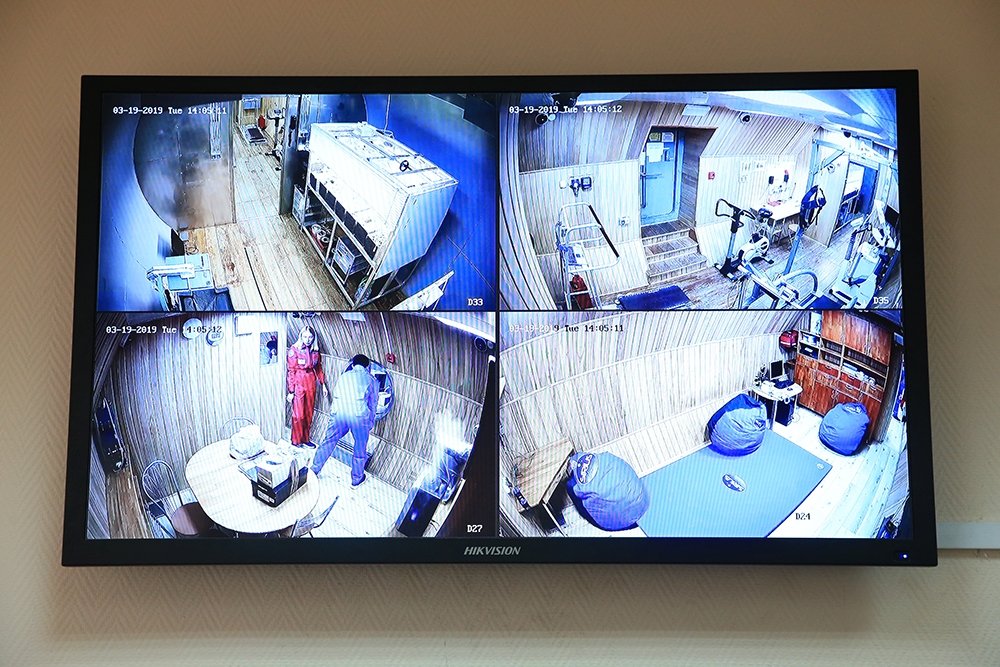
The NEC (ground based experimental complex) involved in the SIRIUS-19 project includes:
- experimental installations (EC) (modules) - EU-50, EU-100, EU-150 and EU-250, intended for scientific research and medical events, permanent residence and crew work, storage of consumable items;
- Alien Surface Simulator (IIP), designed for the physical modeling of extravehicular activity on the surface of a celestial body. The area of the simulated surface is 73.5 m². The SMPS is connected by a junction with the EU-50 and has a room (spacesuit) to prepare the crew for access to the surface .;
- workplaces of staff in the preparation and conduct of the experiment;
- places of eating, resting and conducting personal hygiene of the personnel serving the experiment;
- life support systems of the experimental modules;
- video surveillance and control systems (EHV) of the building in which the NEC is located;
- housing engineering systems in which NEK is located (air conditioning, power supply, cold supply, fire extinguishing, fire alarm, etc.).

Experimental modules EU-50, EU-100, EU-150 and EU-250 are made in the form of sealed metal cylinders, horizontally arranged on supports and interconnected by transition tunnels, equipped with sealed hatches.
In each module it is possible to create its own habitat conditions, including pressure, temperature, humidity, light, and gas composition.
The basic environmental parameters that determine the physiologically comfortable ratio of the main components of the gaseous medium and their total pressure in the compartments correspond to the values specified in GOST R 50804-95 "The cosmonaut's habitat in a manned spacecraft."
To ensure toxicological safety of the gas environment in the compartments, the control is carried out on the substances specified in GOST R 50804-95. Evaluation of the content of harmful impurities in the gas environment is carried out by methods of sampling and analysis of air samples.
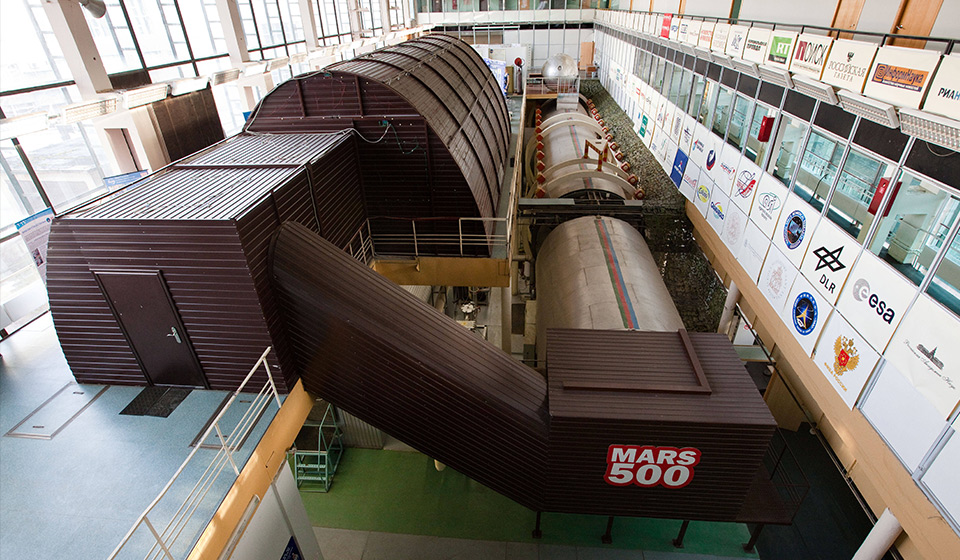
The modules provide:
- visual observation of the activities of the crew and control of the experiments;
- automatic maintenance of the temperature of the gas environment and the possibility of its regulation within the specified limits at the choice of the crew or in accordance with the conditions of the experiment;
- automatic maintenance of a given relative humidity of the gaseous medium within the prescribed limits and removal of excess moisture from the gaseous medium.
In each compartment, a constant automatic monitoring of gas environment parameters is carried out with data transfer to the ground control panel and the EU-150 control panel.
In accordance with the agreed periodicity, the level of microbial contamination of the gaseous medium and the dust level are monitored for compliance with the requirements of GOST R 50804-95.
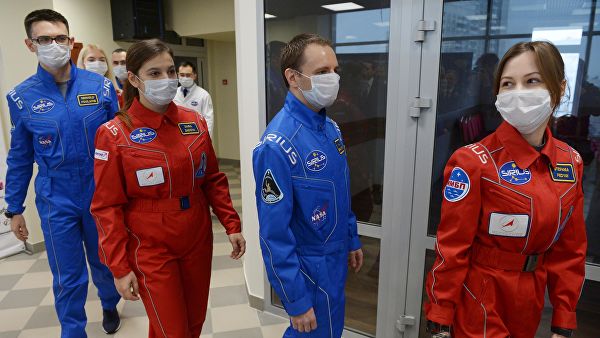
Why is it about the flight to the moon, and the project is called SIRIUS?
The name was chosen for a long time - there were 106 options.
We stopped at this - Scientific International Research In Unique terrestrial Station (Scientific research in a unique ground complex) - that is, SIRIUS.
Sirius - star system, which is located in the constellation Canis Major. The brightest star of the night sky. Many ancient cultures emphasized this brightest star.
The IBMP explains: the name symbolizes the purpose of the project - to shed light on the understanding of human performance in long flights to other planets.
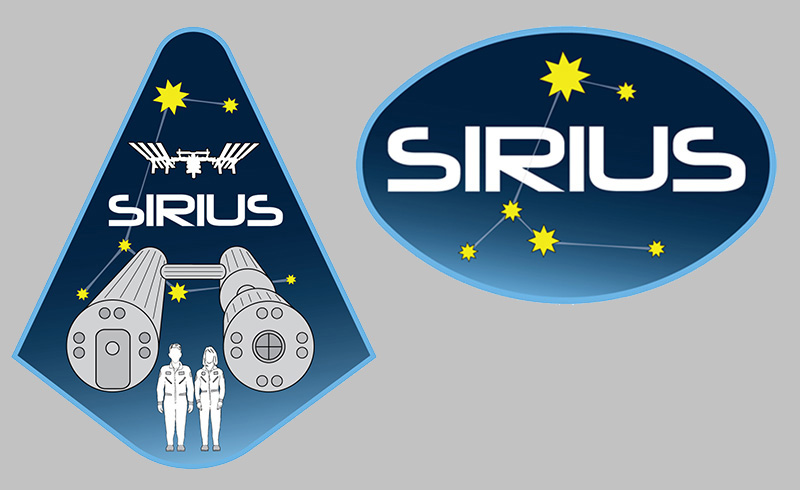
In 2020, an eight-month experiment is already planned at IBMP, and in 2021, an experiment for 12 months is planned.
“I allow the crew of the international experiment to start the experiment,” said the director of the institute, Oleg Orlov.
“We will be back soon,” replied Yevgeny Tarelkin, the captain of the crew, who accompanied him.

Coming out on the simulated surface of the moon, the commander of the crew Tarelkin will be together with the tester Povilaitis.
“While one exit is planned, there may be more there,” said the commander. According to him, during the exit they will take soil samples, will remotely control the rovers.



According to Tarelkin, the participants in the experiment are completely isolated from the outside world - to the extent that they are taken away by cell phones. “This is one of the psychological conditions: no communication, complete isolation. The only thing is that it will be possible to communicate with the family by e-mail once or twice a week, ”he said.
Any member of the lunar crew has the right to leave the experiment, if suddenly it becomes unbearable. He will simply be considered "lost." Strictly speaking, this is the main goal of the experiment on any simulation, including the flight to the moon. As experts emphasize: not technology, but man is the main link in space flight. Regardless of its complexity.
Source: https://habr.com/ru/post/444486/
All Articles